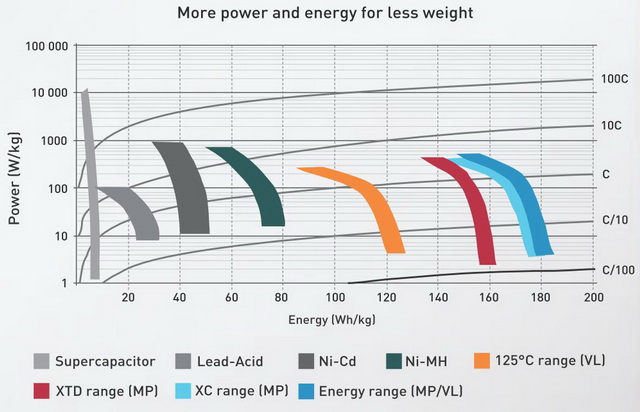LITHIUM-ION batteries
This is the most modern technology. Using lithium means greater energy storage per unit volume and weight. Other advantages are also worth remembering: no memory effect, no vulnerability to deep discharges, very high charging and discharging currents, very high number of cycles, non-toxic components, etc.
On the down side, the cost per stored kWh is the highest and, above all, the safety and stability of the battery can be compromised: all batteries must include a BMS (Battery Management System) which constantly checks voltages and currents and disconnects the battery when it nears points at risk (voltage too low, voltage too high, current too high, temperature too high and asymmetry between the cells)
Replacing cells or construction of the Li-ion pack is thus restricted to licensed professionals. An exhaustive knowledge of the application's energy needs is essential for working out the solution.
Do not confuse (rechargeable) lithium-ion technology with (non-rechargeable) lithium technology.
Saft MP & VL seriesAt the cutting edge of technological innovations in the rechargeable lithium battery field, Saft provides industrial clients with products with exceptional specifications: extended temperature range (down to -50°C and up to +125°C), record number of cycles, greater specific energy (up to 385Wh/l), etc. Whether for retrofit or designing new applications, the performance will meet expectations. The VL series offers cylindrical cells, whereas the MP series offers prismatic cells.
|
 |
||||||
LiFePO4 (Lithium Iron Phosphate)This is one of the most recent lithium technologies. It sacrifices a little capacity but, in return, it brings a number of benefits: extremely high charging/discharging currents, a safety stability comparable with that of nickel batteries, a very low auto-discharge rate (< 20% per annum), a low weight, etc. This technology is particularly well suited to mobility: motorcycle, scooter, wheelchair, quad bikes, sailing, models and campers have much to gain by replacing their lead-acid batteries by LiFePO4.
|
 |
||||||
18650This is the emblematic cell of the lithium-ion revolution. Its small size (18 mm in diameter and 65 mm in length) means it can be accommodated with ease in a satisfactory number of applications and to supply a large amount of energy to these. Its success is closely related to the boom in laptop computers in the decade which began in 2010. Other formats are also available: 10440 (AAA), 14500 (AA), 18500(A), 26500, 26650, 33600 (D), etc. Available in a number of versions, giving priority to capacity, number of cycles, security aspect, etc., it is generally assembled into packs to have a voltage (or capacity) appropriate to the application. As the consequences of using these items incorrectly can be very serious (heating-gas release-fire), the study and design of the battery-application-charger trio is restricted to experienced professionals. Consult us for your projects or any information
|
 |
||||||
Li-PO (Lithium-ion polymer)This made its appearance at the beginning of the century and owes its name to the use of a dry, solid polymer instead of the electrolyte normally accommodated in a porous film. Another feature is their presentation in a flexible pouch rather than in a metal can. Technical limitations have frustrated the development of this technology. Batteries that are currently referred to as "Li-PO" are in fact mainly non-polymer batteries packed in a flexible pouch. Considerable freedom of form, the fragility of the envelope, inflation of the envelope and a more restricted number of cycles mean that this battery is generally reserved for high volume and modelling applications. |
 |







